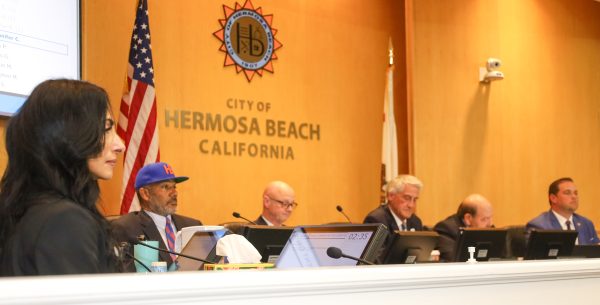
Detective Sgt. Raul “Sal” Saldana, who has worked many of the town’s most high-profile and difficult crime investigations, is hanging up his badge after a quarter century with the Hermosa Beach Police Department.
The retirement of Saldana, 54, effective March 30, will be “a huge loss” to the force, interim Police Chief Steve Johnson said.
“He’s a guy we’re definitely going to miss,” said Lt. Tom Thompson, who has command-level authority over the detective bureau that Saldana supervises on a day-to-day basis.
“I’ve been there as long as Sal has, and I’ve always been impressed with his work ethic and his talents as an investigator. He’s able to deal with so many different people – suspects, citizens, it doesn’t matter,” Thompson said.
Thompson said one of Saldana’s key strengths is drawing confessions and other key information from suspects.
“It’s his personality, he reads the person well. It’s like, ‘Tell Father Sal your sins, and you’ll be saved’ or something,” Thompson said.
“It’s been a great run,” Saldana said.
“The people I work with, we have these relationships. I’ve trained half the cops here. I’ve been to weddings, divorces, baptisms, birthday parties – I’ve introduced guys to their ex-wives,” he said. “It’s a family, it really is.”
Saldana was lead investigator in the high-profile 1995 murder of Hermosan Linda Sobek, a former Los Angeles Raiders cheerleader, whose body was found in the Angeles National Forest.
It was Saldana who convinced suspect Charles Rathbun to lead police to Sobek’s body. In a two-hour interrogation, Saldana spent only about 20 minutes talking about the case itself. Mostly, the conversation was about matters such as where Rathbun grew up, his dog, his mother and his brother, who was an attorney.
Rathbun claimed he had run over Sobek by accident, then panicked and buried her body.
“The only way to prove that’s the truth, to make yourself righteous, is to show us where the body is,” Saldana told Rathbun. “If it was an accident, you have nothing to worry about.”
Authorities put the photographer in a helicopter and flew him over the forest, and watched as he pointed down to the place he had buried Sobek. The body gave investigators ample evidence that she had been attacked, tied and beaten.
“There was no evidence at all that she had been run over,” Saldana said.
He said an effective interrogation is more a conversation than a question-and-answer session. It’s important to study a suspect’s background in advance, and get to know the suspect during the interrogation.
“You have to be able to talk to them, to treat them like a human being,” Saldana said. “You’ve got to get close, sometimes to actually touch them.”
Outnumbered
Two decades ago Saldana found himself outnumbered four-to-one by would-be armed robbers inside Seymour’s Jewelers on Hermosa Avenue. It was a tense scene that ended in bursts of action and a flurry of arrests.
Police had received a call about suspicious activity at the store, and Saldana, who was in plainclothes, strolled through the doors pretending to be a customer. He found four young men who turned out to be “armed to the teeth.”
“They were casing the joint, and they were checking me out. The women [behind the counters] were looking at me like, this is not right,” Saldana said.
As Saldana’s fellow officers quietly closed in on the store, the men inside realized something was up, and two of them bolted and ran, but could not outrun the cops. Another accomplice was found waiting in a stolen car, and he was arrested as well.
Inside the store, the remaining two men were arrested, but not before one of them drew a 9mm handgun.
“I got my .45 behind his ear and took him to the ground, and he dropped his gun,” Saldana said.
Suddenly, it was all over, without a shot fired.
“Those were the longest 15 minutes of my life,” Saldana said.

Armed talk
About a year ago, Thompson said, Saldana’s people skills and restraint were instrumental in the successful handling of a standoff with an armed man who had threatened suicide.
The man’s girlfriend called police to report that he had taken a gun and ammunition from his home, and left a suicide note behind.
“He kept using pay phones, and we tracked him, but we kept getting there too late,” Thompson said. “He made his way from Hermosa to Torrance, and we caught up with him there.”
Saldana and Detective David Bohacik confronted the man as he stood outside his car, within reach of his loaded gun.
“The guy was standing outside the car with the gun on the passenger seat, and he’s looking inside the car, and looking at detectives,” Thompson said.
“Sal said, ‘Come on, you don’t want to ruin my day,’ putting it back on the guy, showing, this is how it would affect me if you did it.’”
The man surrendered, and was taken to Harbor General Hospital in Carson for a 72-hour psychiatric evaluation, but not before a stretch of touch-and-go.
“He took a long time to think about it, and Sal knew he was going to have to shoot him” if he drew down on the detectives, Thompson said. “For a few moments there it wasn’t going well.”
“Predator” nabbed
Saldana has worked bank robberies, the wounding of a woman shot five times in the face, a nearly fatal samurai sword stabbing, and Hermosa’s first homicide case in eight years, the shooting of a woman on the morning of New Year’s Eve, which resulted in the arrest of her boyfriend.
Saldana said the size of the Hermosa police force helped assure him a large number of big cases.
“We’re so small, your turn in the barrel comes around pretty often,” he said.
Two years ago he helped nab Angel Ayala, a Los Angeles man who used Craigslist to prey on gay men.
Ayala met a Hermosa man at his apartment, brandished a handgun and ordered the man to put a television set, a computer, a camera and other electronic items into his own vehicle. Then Ayala ordered the man to drive them to an ATM and withdraw cash.
Ayala kicked the man out of his car and abandoned it inLos Angeles.
“While he was inside the victim’s apartment, the suspect touched a glass,” Saldana said. “We got prints, and from the ATM camera we can see where the suspect touched the [steering] wheel, so we got his DNA there too.”
They zeroed in on Ayala. Before the interrogation, Saldana contacted West Hollywood authorities and found a man matching Ayala’s description was a suspect there as well.
“He admits to West Hollywood, he admits to several robberies, a home invasion in another city,” Saldana said. “The man was a one-man crime wave. He was a predator. He thought crime 24-7. Now he’ll never see outside.”
Ayala was given consecutive sentences that amounted to a life term in prison.
Saldana said he’s seen detectives become jaded “as a defense” against the grim aspects of life they encounter. But he said the job has made him more compassionate.
“You deal with victims, and with the suspects, a lot of them are not really bad people, they’re people who have made bad choices,” he said.

Changing cops
Twenty-five years ago Saldana joined a department with aging equipment and vehicles, and cops who had less book learning and more life experience.
“Like any other industry, things are generational. There are different ways of looking at things. When I came in, cops wereVietnamveterans, they weren’t as young. They had various jobs before coming in. They had more life experience,” he said.
“Now the typical policeman has a bachelor’s degree or a master’s degree, maybe it’s the second job they’ve ever had. It’s a different breed of policeman we work with. They bring in a lot more book smarts, a lot more formal education,” he said. “That’s good in a sense, but when you’re dealing with a job that has so many dynamics to it, life teachings are a lot better than book teachings.”
Changing crimes
A major change in crime has been the influx of perpetrators from outside the beach cities, which came with the rise in the prominence of Hermosa nightlife and the influence of the internet to promote Hermosa far and wide, Saldana said.
“It’s changed considerably, it really has. We used to deal with just the local people here, down in the bars. Now we do a lot more with people outside the area. The demographic has changed considerably because of the bars and businesses,” he said.
“We used to have people committing car burglaries from Hermosa and Manhattan, now we’re contacting gangsters from the Inland Empire, all the way from Bakersfield,” he said.
“There was a transformation from local head shops and tie-dye T-shirt stores, and local bars, to the point that we really got on the map, and you could go on Youtube and see the life down here, the atmosphere,” Saldana said.
Not that crime was nonexistent before it began appearing as an import. Saldana recalled a previous Hermosa bar scene that rose and fell before thePierPlazawas built for the current go-round.
“There were bars you had to have a rap sheet to get in,” Saldana said.
Off the ambulance
After March 30, Saldana said he will continue to work as an investigator in some form, and he looks forward to spending more time with his kids and grandkids.
By calling it quits when he does, Saldana takes advantage of an early-retirement offer from the city, under which he will be credited with two additional years of service when his pension is computed.
He did not set out to become a police officer. As a child he wanted to be a doctor, and at 19 became an ambulance driver. Then when the drivers were being upgraded to paramedics, he had to choose between “paramedic school” and another path.
He joined the Torrance Police Department in 1985, and came to Hermosa two years later. He was promoted to sergeant in 2003. There were no minorities or women on the force when Saldana, who is Hispanic, joined, but he said he never faced even the slightest racism.
“It’s been quite a time, for something I just fell into,” he said. “I can’t believe how fast it went by.”










